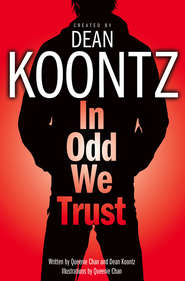По всем вопросам обращайтесь на: info@litportal.ru
(©) 2003-2024.
✖
Jane Hawk Thriller
Автор
Год написания книги
2019
Настройки чтения
Размер шрифта
Высота строк
Поля
She held her breath and heard only silence. Both training and intuition argued that if someone was in the apartment with her, he would have made a move by now.
The silence was broken when a sound rose from below, perhaps someone ascending the stairs.
She returned to the apartment entrance to retrieve her tote. Among other things, it contained $90,000, all of which—and more—she had taken from the stashes of wealthy Arcadians who had tried and failed to kill her. She couldn’t afford to lose it; she was fighting a quiet war, but a war nonetheless, and wars cost money.
The building was old, and the stairs creaked under the weight of whoever was climbing them.
She closed the door. The deadbolt was intact. She engaged it.
5 (#ulink_d21b3a84-3e33-593c-98f8-95cc7345390b)
Mai-Mai serves a small chopped salad sprinkled with pine nuts and crumbles of feta cheese.
Tom Buckle smiles and thanks her and watches her lithe form as she exits through the butler’s pantry.
When the girl is gone, Wainwright Hollister says, “I need to explain how an injectable brain implant might be feasible, Tom. I don’t want you to think of this as a science-fiction movie. It’s a thoroughly contemporary thriller.”
“I know a little about nanotech, Wayne, just enough to accept the premise.”
“Good. Very good. Now suppose hundreds of thousands of these microscopic constructs can be suspended in ampules of fluid and stored at temperatures between—oh, let’s say—thirty-six and fifty degrees, where they remain in stasis. When injected, the warmth of the blood gradually activates them. They’re brain-tropic. The veins conduct them to the heart, then the carotid and vertebral arteries bring them to the brain. Do you know what the blood-brain barrier is, Tom?”
Buckle evidently finds the salad highly agreeable and pauses to swallow a mouthful before saying, “I’ve heard of it, but I’m no whiz when it comes to medical matters.”
“Nor do you need to be. You’re an artist and a damn fine one. Ideas and emotions are the stuff of your work. So … the blood-brain barrier is a complex biological mechanism that allows vital substances in the blood to penetrate the walls of the brain’s numerous capillaries while keeping out harmful substances such as certain drugs. Let’s imagine these amazingly tiny nanoconstructs have been designed to pass through the blood-brain barrier, after which they assemble into a control mechanism in the brain.”
“Could they really self-assemble? I mean … many, many thousands of them?”
“An excellent question, Tom. We wouldn’t have a viable story if I didn’t have an answer!” Hollister pauses to enjoy his salad.
“It’s snowing.” Thomas Buckle points to the windows behind his host.
Hollister turns in his chair to watch the first snowflakes, the size of quarters and half dollars, spiraling out of the low clouds like some jackpot disgorged by a celestial slot machine.
Refocusing his attention on his guest, he says, “The forecast is for twelve inches. Temperature will drop to the low twenties by nightfall. No wind yet, but it’s coming. Winter lingers on these plains. Have you experienced a storm in territory such as this?”
“I’m a California boy. My experience of snow is entirely from TV and movies.”
Hollister nods. “If a man were on the run from a killer on a night like the one coming, his least concern might be his would-be assassin. The weather itself could be the deadlier foe.” Before Buckle might wonder at this odd statement, his host favors him with a beguiling smile. “I’ve got a story in mind for just such a movie. But before I bore you with a second scenario, let’s see if I can make my nano tale convincing to the end. You asked how these tiny constructs could be made to self-assemble in the brain. Have you heard the term ‘Brownian movement’?”
6 (#ulink_7ebcd401-2a2b-5eb5-a054-848dd75c786e)
Jane was at the moment safe behind the locked door of the second-floor apartment, although not safe for long.
This was a two-story building, and like all the buildings on this block—whether two, three, or four stories—it had a flat roof with a low parapet. There would be an exit to the roof somewhere in these rooms, probably by way of a metal spiral staircase tucked into a service closet.
But she didn’t want to go up and out that way. If she got to the roof through a trapdoor or through a stairhead shed, she might discover that they had anticipated her and had stationed one of their own up there to greet her. Then she would have nowhere to go.
Even if no sonofabitch with an XREP Taser waited above, Jane didn’t fancy a wild flight across rooftops as in a James Bond flick. Although the buildings varied in height, they were contiguous, and she was likely to find service ladders bolted to walls to allow roof-maintenance men easy passage from one elevation to another. However, she’d already counted five agents in this operation, so there might be more. And if they had mounted a force of that size, they might also have a drone at their service.
She’d previously survived an encounter with two weaponized drones in a San Diego park, something similar to a DJI Inspire 1 Pro with a three-axis gimbaled camera. An eight- or ten-pound drone couldn’t be fitted with even a miniature belt feed loaded with .22-caliber rounds, because the recoil would destabilize the craft. But those in San Diego featured a low-recoil compressed-air weapon that fired needle-like quarrels perhaps containing a tranquilizer.
The people now closing in on her would not risk using such a drone on a busy suburban street in a commercial district, but they might keep one hovering above the roofs where, if she appeared, she could be at once dropped unconscious without much chance that anyone at street level would see the assault.
The prospect of a machine assailant gave her a deeper chill than did a thug with a Taser XREP 12-gauge, not necessarily for good reason, but because it seemed to herald a new world in which those people not enslaved by nanoweb neural lace would be policed and punished by robots incapable of empathy or mercy.
She went to the front windows of the apartment living room, which faced onto the street and offered her the best—the only—chance of escaping capture.
7 (#ulink_eef3ef74-eaad-5717-9e84-4c9cc70f3d3d)
Sitting with his back to the windows, Hollister is so attuned to the moment, so looking forward to Tom Buckle’s sudden realization of his dire situation, so enthusiastic about the pending hunt, his senses so heightened that he can almost feel the huge snowflakes spiraling through the windless day behind his back, can almost hear those delicate wheels of crystal lace turning as they descend, can almost smell the blood that will form patterns in brilliant contrast across a canvas of snow.
“Brownian movement,” he explains, “is progress by random motion. It’s one of nature’s primary mechanisms, Tom. The easiest way to explain is with the example of ribosomes, those tiny mitten-shaped organelles that exist in enormous numbers in the cytoplasm of human cells. They manufacture proteins.”
When his host pauses for wine, Buckle appears to be dazzled when he says, “Man, you’ve really worked this story out in detail.”
Hollister can feel his blue eyes twinkling with merriment, and he knows his captivating smile has never served him better. “Only because I so very much want you to be part of this, to sign on for this adventure with me. Now, ribosomes. Each one has more than fifty different components. If you break down thousands of ribosomes into their individual components and thoroughly mix them in a suspending fluid, then they ricochet off the molecules of the suspending medium and keep knocking against one another until one by one the fifty-some parts come together like puzzle pieces and, amazingly, assemble into whole ribosomes again. That is Brownian movement. It works with Bertold Shenneck’s control mechanism because each of the components is designed to fit in only one place, so the puzzle can’t assemble incorrectly.”
“‘Shenneck’?” Buckle asks.
Hollister should not have mentioned Shenneck, who had in fact invented the nanoweb implant. Now he covers his slip of the tongue. “As I was working this out, I needed to name some characters. That’s just what I call the scientist who developed the nanoweb implant.”
“It’s a good name for the character, but …” The director frowns. “It sounds a little familiar. We should check it out, make sure there’s not a prominent Bertold Shenneck out there anywhere.”
Hollister dismisses the issue with a wave of one hand. “I’m not wedded to the name. Not at all. You’re better than I am at this.”
Having finished his salad, the director blots his mouth on his napkin. “So how long does it take this brain implant to assemble once it’s been injected?”
“Maybe eight or ten hours with the first-generation implant, but the device will be improved, so it might be brought down to, say, four hours. The subject has no memory of being restrained and injected. Once the control mechanism is in place, his mind can be accessed with a key phrase like ‘Play Manchurian with me.’ Once accessed, he’ll do anything he’s told to do—and think he’s acting of his own volition.”
The key phrase delights Buckle. “That great Cold War movie about brainwashing. The Manchurian Candidate. John Frankenheimer directed from a Richard Condon novel. Sinatra and Laurence Harvey. Angela Lansbury as Harvey’s power-mad mother. About 1962, I think.”
“Shenneck liked his little jokes. The scientist character. Whatever we’re going to call him.”
“My head is swimming, Wayne, but in a good way. I’m really getting into the whole concept. But exactly how does this tie to Jane Hawk, where we started?”
Responding to the call button, Mai-Mai enters to remove the salad plates.
Hollister says, “Just imagine, Tom, that these Techno Arcadians are intent not only on repressing the unruly masses by injecting and controlling selected leaders in politics, religion, business, and the arts. They also want to prevent charismatic individuals with wrong ideas from influencing the culture.”
Tom smiles at Mai-Mai and then responds to his host. “What wrong ideas?”
“Any ideas in disagreement with Arcadian philosophy. Let’s say it’s been decided that controlling these charismatic types isn’t enough, that it’s necessary to remove their unique genomes from society, prevent them from propagating. So they receive a brain implant and are later directed to commit suicide.”
Tom Buckle nods. “Like Jane Hawk’s husband. But how would these people be chosen for elimination?”
“A computer model identifies them by their public statements, beliefs, accomplishments. Then they’re put on the Hamlet list.”
“‘Hamlet’? Why Hamlet?”











